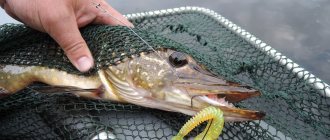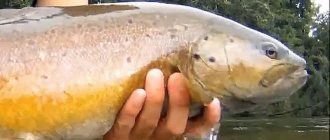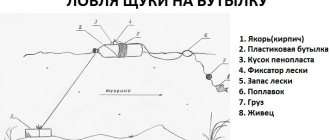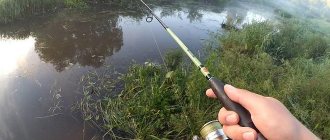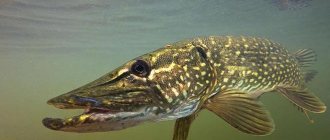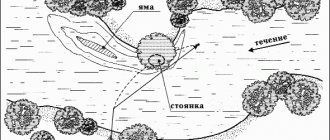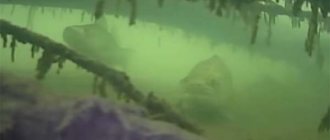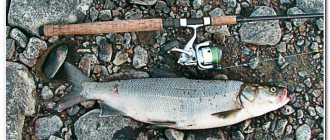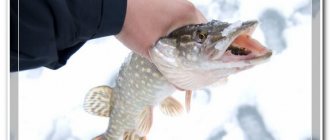Rod selection
The steep edge of the riverbed is a difficult area for fishing with any tackle, but with a float rod you can always find a convenient direct run here. One of the main features of washed-out river banks is that the working depths here begin at the very shore. Usually, to reach a depth of 3-4 meters, a 6-7 meter rod is enough. What it will be - a fly or a lapdog - depends on the choice of bait and fishing conditions. If the bait is steamed cereals, then preference is definitely given to a fly rod. For all its apparent simplicity, this tackle has a whole set of unique qualities. This includes ease of use, the delicacy with which the bait is presented to the fish, and the indescribable sensations that accompany the landing of each bonus fish. If the bait is maggots or pieces of worm, which are best presented at the bottom, then a lapdog is used. However, no matter what gear you use, the rod for live fishing should definitely be rigid and light. But the Bolognese rod must be equipped with several additional rings on the first and second legs. From my own experience, I can say that the more rings there are at the top of the rod, the better.
What is wiring?
The use of float gear (the so-called “Bolognese”) is a prerequisite for fishing from a boat or from the shore to please fans of such fishing with excellent results. The depth of the river should be sufficient for the bait on the hook to pass along the bottom, practically touching it.
The process is not complicated: after releasing the equipment into the water (while avoiding the fishing line getting caught on one of the rings), the reel is released and, placing the float on the current, it is sent into free swimming. The bait on the hook must be moved above the feeding areas.
There are three types of postings:
- the usual simplest technique (passive, with holding and catching with a wire);
- long-distance bait delivery technique;
- short-range wiring technique.

The simplest technique
In this way, the line is easily released from the reel, allowing it to move evenly with the current. This makes it easier for the nozzle to change its position and adapt to the movement of water. A technique that does not require much effort from the fisherman is called passive or free. It justifies itself in places where schools of bottom dwellers gather and when there is active biting.
However, anglers more often use the holding technique, slowing down the unwinding of the fishing line from the reel spool with their finger. In this case, the float stops, moving at a lower speed than the water, and the nozzle rises upward under the influence of the current. After some time, the line is released again, and the tackle moves on. Such movements of the food attract the attention of the fish and provoke them to swallow the bait.
In cases where the float, while being held, jumps out of the water column or rapidly approaches the coastal zone, the number of manipulations should be reduced.
The technique of fishing with a wire is that the weight and leash move along the bottom, and the bait moves in front under the influence of the current.
From time to time the angler must hold the tackle. The wiring will be effective if the depth is set correctly and the antenna on the float tilts with the current. The application of the technique proves its effectiveness in the case when a school of fish is in the middle layers.
To learn more:
Mikado fishing rods: beware of fakes!
Far technique
The wisdom of this option is that the gear allows you to swim a distance of 20-30 meters. It should be noted that the initial casting distance should not exceed the length of the rod by more than twice. Long-distance fishing is preferred in water areas with strong currents and depths of no more than three meters, as well as in cases where a diligent fisherman has to fish hard-to-reach places, and casting is done in a strong tailwind.
In practice, this wiring is carried out according to the following scheme: the float is thrown to the required distance from the shore line, for some time it moves downstream to the original point of wiring. Then, by controlling the holding force of the floating float, it is forced to move along the desired trajectory.
In cases where the wind blows the float towards the fisherman, the tackle must be cast further away, and when he approaches the starting point of the retrieve, move it to the required distance with the help of a rod, controlling the strength and holding time.
Close wiring
This fishing technique is most common and is used in places with great depths and slow water movement. It depends on the influence of the wind (a vortex with the current interferes, but against it helps), and strong gusts do not allow the use of short-range guiding methods at all.
This type of bait delivery is carried out at distances ranging from 10 to 15 meters. It allows you to fish over long distances (maximum performance depends on the length of the rod used and the depths in the fishing areas). Such postings require close attention to ensure that the telescope or feeder stick is located towards the shore, and the angle between the float and the fishing line hanging from the tip of the rod relative to the angler’s location is close to 90°.
You need to get used to the process, since at first it will be difficult to keep the float on the desired trajectory. The success of fishing depends not only on the speed of the current, the number and frequency of holds, but also on the weight of the equipment. Weakly loaded tackle is harder to stop in time, but if you make it heavier, you will lose the sensitivity of bites.
Coil
There are no special requirements for choosing a reel for Bolognese fishing, and it is quite possible to use spinning models with a spool size of 2000-2500 according to the Shimano classification.
The main thing is that the reel is not heavy and does not disturb the overall balance of the gear. After all, throughout the entire fishing trip, and sometimes you have to fish for 3 or 4 hours, the rod is constantly in your hands, so it is vital to count every extra gram of weight. Some reel models have interesting design solutions that not only make fishing much more exciting, but also allow you to fish with thinner gear without any problems. One such solution is a rocker arm, which can be used to regulate the braking force during the process of landing fish.
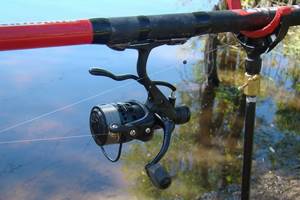
fishing line
As a rule, when fishing along washed-out banks, you are dealing with large fish.
Taking this into account, a monofilament with a cross-section of at least 0.2 mm should be taken as the main fishing line. With proper organization of fishing, fishing lines of this cross-section can cope with very large fish. Another potential problem is the presence of multiple obstacles on the river bottom. Losing all your gear at your fishing spot can completely ruin your fishing day. This is another good reason to use a thicker mainline.
What kind of fish can you catch?
When fishing at sea, you can catch completely different species of individuals. It is quite difficult to predict what kind of fish you will be able to get today. Often found at sea:
- sea urchin;
- cod;
- mackerel;
- horse mackerel;
- mackerel;
- red mullet
In less salty waters or at river mouths you can catch:
- pike;
- salmon;
- pike perch;
- perch
The methods of catching fish can also be different, but you need to choose the right bait. Fishermen with extensive experience even hunt sharks in the sea. To catch such an aggressive predator, you will need to show cunning, as well as withstand the physical stress that will undoubtedly arise when fighting it.
This fish is caught from a boat or yacht. Fans looking for small sharks can find them on the shores of Bulgaria or Crimea. Larger specimens live off the coast of Africa. When fishing, you need to take care of the boat and the choice of spinning rod in advance. It does not have to be long, but the main thing is that it is strong and elastic.
Floats
The choice of this part of the equipment should be taken very seriously. When fishing on a steep river edge, where large, experienced fish live, a correctly selected float will not only allow you to notice the bite in time, but also correctly present the bait to the fish.
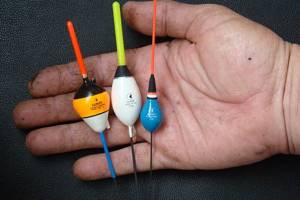
The best body shape of floats for fishing at great depths and strong currents is, of course, a ball or a drop. Such floats do not fall to one side and do not dive under the water when the angler tries to hold the equipment in one place.
When fishing in the current, do not be afraid of thick antennas. An antenna 4-5 mm thick is not only clearly visible at a considerable distance from the fisherman, but also additionally stabilizes the float. Thanks to the thick antenna’s own buoyancy, the float becomes insensitive to minor hook hooks on the bottom. And thus allows the angler to avoid many false hooks.
Loading equipment
When fishing along washed-out river banks, there are two options when choosing the carrying capacity and loading scheme of the floats.
It all depends on which attachment you choose. If you fish for steamed cereals, then it is best to use the lightest possible float - 1-1.5 g, and fish in the water column. If you use maggots, casters or pieces of worm as bait, then it is better to let the bait along the bottom and use heavy floats. For a long time I loaded floats using a chain of sinkers of decreasing weight. With light floats this did not cause any particular problems. It’s a completely different matter when you need to load a float with a carrying capacity of 5 grams or more. You can't do without a massive sinker here. Such equipment gets tangled less, and the hook with the nozzle reaches the working horizon faster.
Depth sounding
Oddly enough, on steep river edges it was most difficult to decide on the tactics for feeding fish.
However, after participating several times in fishing competitions with a float rod, I made several important discoveries for myself. Almost all competitions are held on embankments and dams that have a significant slope. Tens of kilograms of bait are thrown into the water at a time. It would seem that fish should come running to such a feast from all over the reservoir, but that’s not the case. Some athletes catch fish consistently, others only participate in the crowd. And the main reason for the lack of bite is the illiterate use of bait, which safely rolls down the slope of the dam, and the fish follow it.
On amateur fishing, everything happens approximately the same.
Films about good fishing
A lot of good works have been made about fishing: there are feature films, educational works with stories about fishing devices. The first place is occupied by the film “Peculiarities of National Fishing”, which shows episodes of fishing, but this is not the main theme of the film. Educational films about fishing, selection of gear and complementary foods were made by the Shcherbakov brothers. The film “Fish with Us” shows different ways of catching different types of fish. It tells about the choice of gear for winter fishing and summer fishing. It also describes places where you can go fishing in our country and abroad. We are also talking about the choice of gear and devices, how to choose a float rod, a fishing rod for fishing for predatory fish. Tips on how to measure the depth of a reservoir, determine the quality of the bottom, and a story about all the details of fishing.
You can ask your question to our author:
Lure
The final choice of bait depends heavily on the tactics you want to use.
If you are going to fish with steamed grains and cast bait in the water column, then it is best to feed the fish with the same steamed grains and do it in bulk by hand. If you fish from the bottom, you will need heavy and viscous bait with a high content of animal components in the form of casters, maggots and chopped worms. The starting feeding point usually consists of 12-15 balls of bait the size of an orange. They are thrown into the water directly opposite the point where the fisherman is standing. I throw them into the water a little closer to the distance at which the wiring will be done. I carry out further supplementary feeding of the fish according to the following scheme: 2-3 tightly molded balls of bait every 15-20 minutes of fishing. Large fish love to eat tasty food, so there should always be bait in the fishing area.
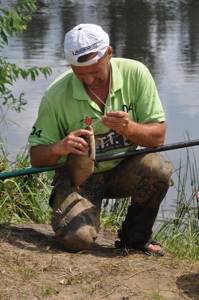
Photo by the author
Some tactics
When fishing with fishing, one of the most important tactics is holding the rig.
And if when fishing for roach or silver bream you need to hold the float so that the bait on the hook periodically rises above the bottom, then when fishing along washed-out river banks, especially if the purpose of fishing is bream, the equipment must be held almost constantly. For complete control over the movement of the bait, after the float takes its working position, the rod rises up and the retrieval is carried out on a tensioned line. This technique is not difficult to learn. Usually, after one or two fishing trips, a long hold, in which the bait constantly strikes along the bottom, begins to work out well. However, all the theoretical calculations that were outlined above will turn out to be completely useless if you do not learn how to properly land fish. If you let the process of catching fish take its course, a cliff cannot be avoided. So, immediately after hooking, you just need to lift the rod up and, without forcing events, keep the fish on it.
Each such “float” bream is much more valuable in terms of the amount of adrenaline released into the blood than bream caught on a donk. Isn't this a reason to once again recall the undeservedly forgotten fishing technique?
Nikolay Linnik
Collecting fishing gear
Fishing equipment for catching fish in a retrieve must combine not only the design and installation of equipment (rod, line, hooks, sinker, float, reel) but also knowledge of other aspects (bait, feeding). Let's take a closer look at them, since the correct design for wiring is the main tool.
Rod selection
To fish with this method, you need a rigid and at the same time light stick, for example, a telescope 4-5 meters long, equipped with rings. They make it easier to unwind the fishing line, turning the fishing process into a comfortable experience. Feeder rods have also proven themselves to be good on retrieves, and the leger type is the best. Quite tough and light, they can withstand playing large fish and do not tire your hand. The optimal length of such rods is 360-390 cm.
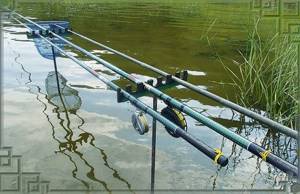
Line selection
For fishing in the wire, the tackle is equipped with a main vein 0.22-0.3 mm thick (100-150 meters), to which a leash with a fishing line diameter of 0.14-0.2 mm and a length of up to 40 cm is attached using a swivel. The equipment allows the tackle be more catchy, and in case of a snag, only the leash is lost.
Coil selection
For this fishing method, you can choose any modification depending on how comfortable it is for the fisherman to use. When you first try to learn how to catch trophy specimens using the reeling method, you can get by with inertia-free models, which are in the arsenal of all fishermen. Reels of this type are good for long, precise casting and when fishing in inconvenient places.
The advantages of coils are:
- simplicity and accuracy of casting over long distances;
- ability to quickly reel out fishing line;
- the presence of a friction brake, which reduces the number of gear breaks.
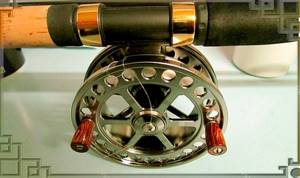
The main disadvantage is the lack of easy descent of the fishing line. Over time, you can switch to inertial types, which, when winding, prevent the veins from twisting, and when wiring, gently lower them, guaranteeing constant tension. The advantages of such reels:
- uniformity of line descent;
- absence of circles between the float and the rod on the water surface;
- ease of vein control;
- accuracy of casting into hard-to-reach places and when fishermen are crowded;
- minimal formation of “beards” when delivering bait.
To learn more:
Shitik in the house: caddis larvae as catchable bait
Float selection
Since wire fishing is carried out in the current, the buoys must ensure the smoothest possible movement of the equipment in the fishing areas and clearly indicate the moment of the bite. Such requirements are satisfied by models attached to the fishing line at the top and bottom. Floats with a long keel (guaranteed stability in currents and strong winds) and antennas in bright colors (they are visible when casting over long distances) are suitable for use.

These floats are appropriate in cases where fishing by wire is carried out at depths comparable to the length of the fishing rod. In other conditions, it is appropriate to use sliding structures.
Sinker selection
The optimal installation for weighting fishing tackle is to mount several lead peas below the float. The heaviest one is placed under the bite indicator, then a smaller droplet, and the lightest one at a distance of 10-15 cm from the hook. This is the best design for cases when fishing in the current takes place.
You can also load the tackle with one sliding-type lead droplet. Such equipment is appropriate when casting over long distances. The disadvantage is low sensitivity and lack of good “play” of the nozzle.
Requirements for hooks
The Bolognese fishing rod for retrieving requires careful selection of the tip for the nozzle. Preference depends not only on the size of possible trophies, but also on the size of the bait. For example, for maggots, a point with an extended fore-end No. 12-14 would be acceptable. Accordingly, for a leech or a worm you will need a larger size. Regardless of the size and shape, the hooks must be strong and sharp in order to reliably hook the fish and not lose it during the fishing process.
Selecting a nozzle type
Maggot has proven itself to be a stable bait that works in different weather conditions for wire fishing. Based on the size of the hooks, 3-5 larvae are placed on them, piercing the edge of the head with the tip. It is advisable to hide a sting in one of the maggots.
The bloodworm proved to be no less catchy bait. But before fishing in the retrieve on the river (Oka, Buzan, Volga, Don) or other waters, you must remember that this bait is quite delicate and cannot withstand more than one cast. Bloodworms are also a very consumable bait, but as part of a “sandwich”, supplemented with maggot larvae, it promotes good results.
Directly near the fishing spot you can find burdock caterpillars, bark beetle larvae and caddis flies. Such baits work well in the spring and not only attract fish, but also give them a wild appetite. Knowing the habitats of larvae and caterpillars, you can save tens of rubles.
To learn more:
The best weather for pike fishing
Vegetable baits are also used for wire fishing. Some fish species, such as ide and roach, prefer them. At home, you can prepare pearl barley and rolled oats, boil peas and semolina porridge. Sometimes even balls of white bread crumb become a delicacy for fish.
Choice of bait
When planning to fish with a wire, it is not necessary to stock up on a large number of baits that attract fish. But it is also impossible to say that they will be superfluous. With the help of soaked bread crumbs, pearl barley grains mixed with clay and sand, you can attract a large flock. The main thing in this matter is not to overdo it and not to overfeed the object of the hunt. Otherwise, the satiated river inhabitants will stop responding to any bait.
